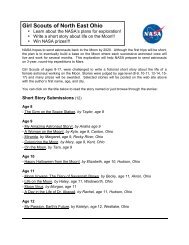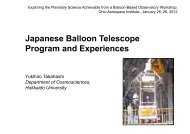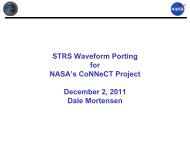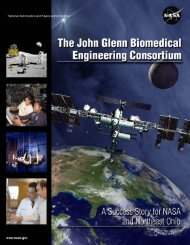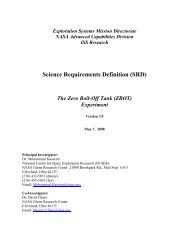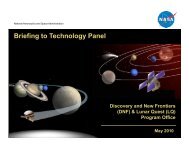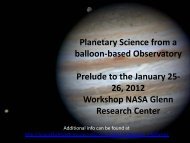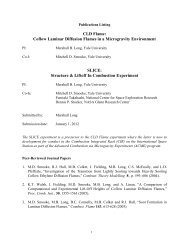Amusement Park Physics With a NASA Twist - Space Flight Systems ...
Amusement Park Physics With a NASA Twist - Space Flight Systems ...
Amusement Park Physics With a NASA Twist - Space Flight Systems ...
You also want an ePaper? Increase the reach of your titles
YUMPU automatically turns print PDFs into web optimized ePapers that Google loves.
Basic Skills<br />
Students who go to the park without mastering the following<br />
skills have difficulty completing the ride worksheets in the<br />
next section. To have a successful physics day experience at<br />
the amusement park, students need to<br />
1. Practice and successfully use a stopwatch to time rides.<br />
2. Know how many average steps to take to walk 30 meters.<br />
3. Measure eye level height.<br />
4. Practice using the altitude tracker and accelerometer.<br />
5. Practice and master two methods for estimating heights.<br />
6. Review how to calculate average times, average speed, how<br />
to correctly use the Pythagorean theorem, and how to use<br />
the equation for finding the period of a pendulum.<br />
A vibration is one back-and-forth motion.<br />
Time<br />
Time is an important measurement for calculating speed and<br />
acceleration. Students can use stopwatches to time a ride’s<br />
duration, portions of rides, or a series of movements to<br />
calculate the average ride speeds. Stopwatches and digital<br />
watches with stopwatch features are the best. Digital and<br />
analog watches with second hands may work well with high<br />
school students. Students need practice taking several readings<br />
to improve accuracy and get practice calculating average<br />
times and speeds.<br />
For fast movements it sometimes is easier to time a series and<br />
divide to find the single motion. For example, a student gets on a<br />
swing and has established a consistent arc. The partner times<br />
the rider for 30 seconds and counts the number of vibrations<br />
(one vibration is a back-and-forth movement). The partner can<br />
then divide the time, in seconds, by the total number of vibrations<br />
to calculate the period (period = time/number of vibrations).<br />
These students are finding the average<br />
number of steps they take to walk in 10<br />
meters along a hallway in their school.<br />
Distance<br />
At the amusement park, one cannot interfere with the normal<br />
operation of the rides, such as jumping gates and shrubbery<br />
to measure ride diameters and distances. Measuring the<br />
length of a normal step is a relatively reliable way to gauge<br />
distances. Many of the ride worksheets require measuring hill<br />
distances or using baselines for angle measurements to<br />
calculate ride heights. Use a metric measuring tape or meter<br />
stick to mark 10 meters in a hallway or parking lot, with strips<br />
of masking tape or chalk. Students can practice walking this<br />
distance and counting their steps. Each step counts as one.<br />
Have students determine the average number of steps they<br />
26<br />
<strong>Amusement</strong> <strong>Park</strong> <strong>Physics</strong> <strong>With</strong> a <strong>NASA</strong> <strong>Twist</strong><br />
EG–2003–03–010–GRC



